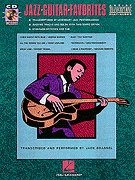JAZZ GUITAR FAVORITES LIBRO CD TABLATURE CHITARRA-All The Things You Are-Hank Garland-KESSEL
JAZZ GUITAR FAVORITES. CD TABLATURE
LIBRO DI MUSICA, SPARTITI PER CHITARRA CON CD E TABLATURE.
6 titoli:
-All The Things You Are, Hank Garland
-I Hear A Rhapsody, Howard Roberts
-Oleo, Pat Martino
-Speak Low, Barney Kessel
-When Sunny Gets Blue, George Barnes
-Yesterdays, Wes Montgomery
Series: Guitar Collection
Medium: Softcover with CD
Arranger: Jack Grassel
Guitar transcriptions for these standards: All The Things You Are/Hank Garland - I Hear a Rhapsody/Howard Roberts - Oleo/Pat Martino - Speak Low/Barney Kessel - When Sunny Gets Blue/George Barnes - Yesterdays/Wes Montgomery.
40 pages
Table of contents :
All The Things You Are
I Hear A Rhapsody
Oleo
Speak Low
When Sunny Gets Blue
Yesterdays
INTRODUCTION
This publication represents a new format in jazz education which allows the learning improvisor and professional to access the benefits of studying classic guitar solos. Most transcription books require that the recordings (if available) be searched out, purchased, and only listened to since most players in the developmental stages of their playing would not have the technique to play the solos up to tempo. The solos in this book are:
1. Played in tune; many old recordings have been sped up to improve fidelity, raising the pitch as much as a whole step.
2. Recorded at an easy-to-play slow practice tempo.
3. Also recorded at a fast tempo slightly slower than the original, making performance attainable sooner.
4. Recorded on modern equipment with fidelity surpassing the original recordings with a modern rhythm section. Bass and drums are monophonic on both channels. Piano is on the right only. Guitar is on the left only.With your "balance control" you can choose what you want to hear. The solos are arranged in progressive order of technical difficulty.We chose performances that are most representative of each master's contribution to the development of jazz guitar.
Barney Kessel: This solo demonstrates his use of hard-driving melodic development and some of the first string bending on record by a jazz artist.
Wes Montgomery: The tone of the jazz guitar was forever changed by this man's thumb while adding to the post-bop vocabulary.
Howard Roberts: This early solo displays his formidable jazz talent which became unavailable to the public as Howard persued his pop hits, studio work and teaching careers in the late sixties.
Hank Garland: This Country-Western studio player shocked the jazz world in the early sixties with
his incredible jazz technique and swinging melodies.
George Barnes: With the use of almost every technique known to man, George uses bending, slides,
and hammer-ons to create a high level of expression seldom heard on the guitar.
Pat Martino: This solo is from the seventies after Pat had left his Wes Montgomery-influenced early
playing and developed his present polytonal-chromaticism, which is much different than the traditional jazz guitar approach.
The final form you see here is the result of an entire year of work; researching and choosing great solos, transcribing and proofreading for accuracy, countless hours of practicing and recording. Our motive is to increase the quality of jazz guitar playing and to preserve music which is or may become "out of print." Jeff Schroedl at Hal Leonard was a big help in developing and improving the book.
Up until starting this project I had avoided playing other's solos thinking that my own unique style of playing would be compromised. After spending a year with these masters, I've noticed that I have retained my original conception of guitar music, but have acquired a technical depth and more tools to play my music my way. So I now recommend this study to any jazz guitarist at any level.
Special thanks to the fine rhythm section who did their homework: Jim Sodke-keys, Del Bennett-drums, Tom McGirr-bass, and also Bill Littlefield-recording engineer.


